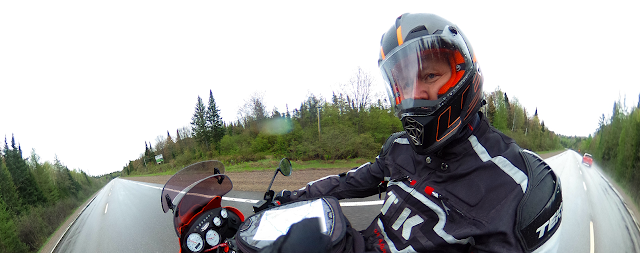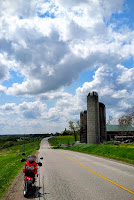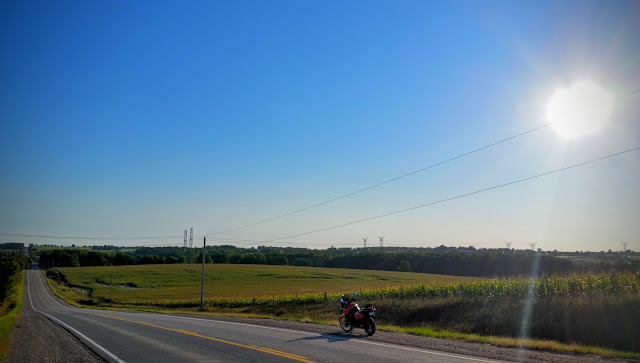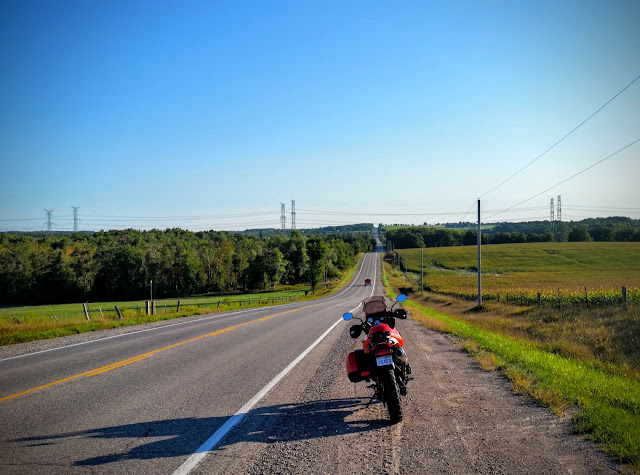Almost three hours into an interminable visit to the local walk-in clinic last Friday night I’m told that I’m over a hundred degrees, in terrible shape, but it’s just a virus and I have to suffer through it. I should go home, rest and feel better, except I can’t because this is the Haliburton Birthday Weekend. We’re on the hook for a hotel that won’t cancel a long weekend booking, even under a doctor’s advice.
I go home, sleep poorly and take lots of pills. The next morning I’m shaky and either sweating or freezing cold, so a perfect day to go for a three hundred plus kilometer ride across the province. The original plan was to leave early and take my time picking off must-ride roads in the south end of the Haliburton Highlands before finally arriving at our hotel near the town of Haliburton. That didn’t happen. Instead, I followed my wife and son in the car on the shortest possible route. We stopped frequently and a sunny, relatively warm day meant it wasn’t as miserable as it could have been. We all fell into our room after five o’clock and collapsed.
 I could have driven up in the car, but the whole point of the weekend was to ride the Highlands, so bike it was. Sunday morning dawned overcast with heavy clouds. The rain held off until I saddled up after a late but brilliant breakfast at the Mill Pond in Canarvon. I was doped up on fever and flu medication and as good as I was going to get. The plan was to wind up Highway 35 to 60 and then into Algonquin Park. If the weather was atrocious or I fell apart physically I could always turn around, but if I’m going to do it, I’m going to do it; turning around isn’t in my nature.
I could have driven up in the car, but the whole point of the weekend was to ride the Highlands, so bike it was. Sunday morning dawned overcast with heavy clouds. The rain held off until I saddled up after a late but brilliant breakfast at the Mill Pond in Canarvon. I was doped up on fever and flu medication and as good as I was going to get. The plan was to wind up Highway 35 to 60 and then into Algonquin Park. If the weather was atrocious or I fell apart physically I could always turn around, but if I’m going to do it, I’m going to do it; turning around isn’t in my nature.
I’d originally planned to stop often and use the new camera, but needs must and I was on a mission to complete that fucking loop. The backup plan was to use the Ricoh Theta 360 camera on the fly. It’s a push button affair that is easier to use than a satnav. Hit power, press the shutter button, put it away. The tank bag that came with the Tiger has a handy little pouch at the front that fits the camera perfectly. I’d never tried using the Ricoh by hand like that before, but it seemed like a good idea when my time on task was at a premium. Since it takes in everything at once you don’t need to worry about aiming or focusing it either.

Heading north out of Canarvon the rain closed in immediately. On the upside, it was chasing away a lot of the holiday traffic, though this is Canada, so what you’re looking at above was pretty typical for this ride… on a long weekend.
Highway 35 dodges and weaves around lakes and Canadian shield as it works its way up to meet 60. If you’re not blasting through the dynamited, rocky skeleton of Canadian Shield, you’re winding your way around muskeg, never ending trees or scenic lake shores. And it does all of this while being a bendy roller-coaster of a road.
The gas station in Canarvon was shut down, so I suddenly found myself running onto empty as I powered north into the big Canadian empty. Fortunately, I came across a Shell station at the intersection with 60 and filled up.
By that point the rain was more steady than not, so I stepped into the rain suit and wove my way into Algonquin Park. Suddenly the roads were full of people with GTA tagged SUVs all driving around aimlessly looking confounded by all the trees. Throughout the entire loop Algonquin was the only time I was stuck in traffic. I pulled in to the Visitor’s Centre and had a coffee, stretched my legs and soaked up the ambience. The lady at the counter was nice enough to give me ten cents off on my coffee because I didn’t have change.
Fifteen minutes of crying babies and screaming kids and I was longing for the wind and silence of the road again. The Visitor’s Centre was near the half way point in the loop, and with a coffee in me (my first caffeine in days) I was ready to go all the way. The weather was occasional spotty rain, so it wasn’t as terrible as it could have been. I was warm and dry in the rain suit and the drugs had beaten back the fever, so on I went.
I’d never been out the East Gate though I’ve been to Algonquin since I was a relatively new, ten year old immigrant to Canada. It feels older than the West Gate, looking more like a toll booth than an art deco entrance to one of the biggest and most famous parks in the country. Once out of the park traffic evaporated and I was once again alone in the woods. I’d originally planned to head all the way over to the 503 for a wiggly ride south, but 127 cut off some kilometers and I was already feeling the hours in the saddle. It was an empty trek down the 127 to Maynooth, albeit with some pretty scenery.
The rain came and went and I got so used to riding on twisty roads that it became second nature. What would have been a ride to road where I live was just another road in Haliburton. The Tiger spent very little time on the crown of its new Michelins. I pulled up in Maynooth for a stretch before starting the final leg of the loop back over to Haliburton Village.
Strangely, and for the first time since the trip began, the roads dried up and the sun started poking through. Up until now I’d been on local highways; fast, sweeping roads that, while curvy, were designed for higher speeds. Out of Maynooth I took Peterson Road and got to enjoy my first local road with lots of technical, tight radius turns and elevation changes. Peterson and Elephant Lake Roads were dry and a lovely change from the wet highways I’d been on before.
 |
| On a short straight between the twists on Peterson Road out of Maynooth. |
 |
| Those 41 winding kilometres to Pusey flash past in no time! |
The local traffic was apparently very familiar with bikers making time through the area with several trucks pulling over and waving me through; some country hospitality on a long ride.
The pavement continued to dry and the Tiger got friskier and friskier as I rode on to Pusey and then Wilberforce. I was lucky to see another vehicle in either direction on this busy long weekend – just my kind of road trip. No matter how sick I’m feeling there is nothing like a winding road and a motorbike to put a spring in my step. For the first time on this ride I wasn’t carefully monitoring my health and the weather, I was just enjoying being out in the world on two wheels.
The sun battled with clouds all the way under Algonquin Park and I soon found myself lining up for an approach back toward Haliburton, this time from the east. Once again I elected to cut some extra miles out, forgoing a ride to Gooderham for the joys of the 118.
Swooping through the lake of the woods while leaning the ever eager Tiger around lakes, trees and rocky outcroppings had me in nirvana; it was like riding through a Group of Seven painting.
By this point the drugs were wearing off, I’m starting to wilt and the deed is almost done. The last few miles into Haliburton turn ominous as dark clouds fill the horizon and the temperature drops. I steel myself for the final push.
As the sky fills in and the rain starts to fall again, my goal is in sight. I pass through the small town of Haliburton like a ghost and pull up just as house keeping has cleaned our room (the family is out at the pool). Ten minutes later I’ve taken another round of drugs and I’m in a whirlpool tub getting the heat back into me.
The logic I followed doing this was: any day on a motorcycle is a good day. Even with a fever and a nasty virus I had a great ride and a real sense of satisfaction in completing my birthday loop of the Haliburton Highlands. It would have been nice to do it without feeling like I’d been turned inside out, but hey, any day on a motorcycle is a good day.
The ride: a 270 km loop through Algonquin Park and back around to the town of Haliburton. All told I was on the road for about four and half hours, including a gas stop, a coffee at the Algonquin Visitor’s Centre and a leg stretch in Maynooth.
The camera: a Ricoh Theta SC. It takes two hemispherical photos in both directions and then stitches them together, which makes the camera disappear in any photos it takes – which is pretty freaky.
Having all hardware buttons, you don’t have to futz around with a smartphone to interface with it like you do with the Fly360. As a camera to use while photographing a motorcycle ride it doesn’t come much easier than this. It’ll do video and save it in 360 format so you can look around in the video on a smartphone. It does the same thing with photos.
The photos in this piece were opened in the Ricoh software and then screen captured. That’s how I cropped images to show various things. The original, unedited photos are pretty funky (see below), but look good with some judicious cropping.

Where we stayed: The Pinestone Resort just south of Haliburton. The prices are reasonable and you get a nice room. The facilities are good with golf on site (if you care about that sort of thing) and a salt water pool and sauna. The onsite restaurant had us waiting 90 minutes (in my case for a French onion soup and salad) and isn’t cheap. Eating elsewhere might be a good idea, especially on a busy weekend, but anything else is at least a ten minute drive away in town. We stayed there last summer on our ride back from The Thousand Islands and it was good – they seemed to have trouble handling the traffic on a long weekend this time around though.
from Blogger http://ift.tt/2r39YWs
via IFTTT



Having tapped into this trend while it was still only popular in continental Europe, Triumph’s Tiger line has been a key part of their brand for the past twenty plus years. If asked what bike I’d want to take around the world tomorrow, the Tiger Explorer is at the top of the list.




















